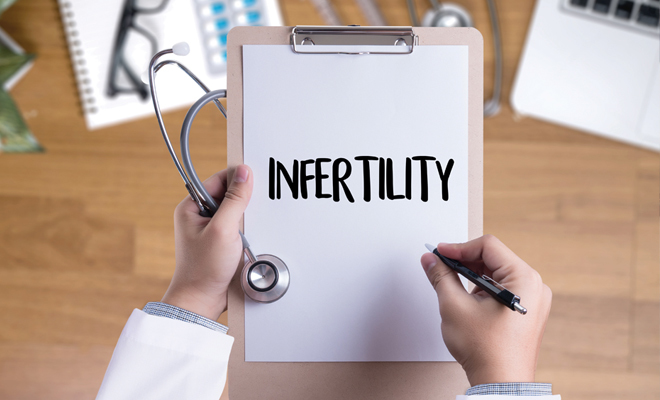
Overcoming Infertility
Q. What is infertility?
A. Infertility is a disease or condition that interferes with the ability to get pregnant after having regular unprotected sex for one year. “Regular” is considered every few days when a woman is ovulating, or the time of the month when one or more eggs are released from the ovaries. If the woman is over 35 or if there is a history of irregular menstrual cycles or diseases of the reproductive system, the couple may want to seek help sooner than the 12-month time frame. About two-thirds of people who are treated for infertility will become pregnant.
Q. What are the primary causes of infertility?
A. In women, the most common cause of infertility is an ovulation disorder. Ovulation normally occurs once a month, usually around the middle of the menstrual cycle, which averages 28 days in most cases. Women with an ovulation disorder may not ovulate at all or they may ovulate irregularly.
Other common causes in women are blocked fallopian tubes, a condition that prevents the fertilized egg from traveling to the womb, and hormonal deficiencies that make the uterine lining unprepared for egg implantation or that keep a pregnancy from being maintained.
In men, the main cause of infertility is a sperm disorder. A man may have no sperm or low sperm count, or there could be a problem with how the sperm is moving or the shape of the sperm.
Q. What are common risk factors for infertility?
A. Primarily, it’s age. A woman’s ability to get pregnant starts declining in her early 30s and takes a big drop after age 35. According to the American Society of Reproductive Medicine, a healthy 30-year-old woman has about a 20 percent chance each month of getting pregnant.
By age 40, that chance is only about 5 percent. The main reason for this decline is that women are born with all the eggs they will ever have, and the supply of eggs goes down with age with each menstrual cycle. The quality of the eggs also decreases, which increases the likelihood of miscarriage in older women.
Men continually produce sperm most of their lives and they don’t experience the sudden drop in fertility that women do. A man’s fertility may decrease gradually over time but less dramatically than it does in women. There is also evidence that the risk of gene problems in sperm increases with advancing age.
The incidence of infertility also goes up when there is medical disease or surgery that could damage the reproductive organs, such as pelvic inflammatory disease. This infection can lead to infertility because it scars the uterus and blocks the fallopian tubes. Men may develop problems due to prostate surgery or problems with the testes resulting in abnormal sperm production.
Lifestyle modifications include quitting smoking, reducing or eliminate alcohol intake and recreational drug use, and prevention of sexually transmitted diseases. In women, extremes of body weight can interfere with the production of estrogen, which regulates the menstrual cycle and ovulation. According to the American Society of Reproductive Medicine, too much body fat causes a woman to produce too much estrogen. Too little body fat causes a woman to produce too little estrogen.
Q. What tests and evaluation should we expect?
A. Expect detailed medical and sexual histories of both partners and a comprehensive physical exam. Men will have a semen analysis that evaluates sperm count, shape and movement.
For women, evaluation for ovulation is the first step. This can be determined and monitored through blood tests that detect ovulation hormones, ultrasound examinations of the ovaries, or an ovulation home test kit. If ovulation is established, then a hysterosalpingogram, a type of X-ray of the fallopian tubes and uterus, is performed. This test involves placing a dye solution into the womb’s cavity. A series of X-rays are taken. If the fallopian tubes are open, the dye will flow through the tubes and spill into the abdominal cavity. If the fallopian tubes are blocked, the dye will be retained in the womb or fallopian tubes, depending on the site of the obstruction.
Additional tests are ultrasound scan, hysterosonography and laparoscopy, a more invasive surgical procedure that can examine the ovaries, uterus, fallopian tubes and abdominal cavity. A blood test for ovarian reserve can see how the ovaries will respond to various fertility treatments. This test measures blood hormone levels on the third day of the menstrual cycle. If the test is normal, it doesn’t guarantee fertility. But if the numbers are abnormal, it is suspicious of a serious problem.
Q. What are the conventional treatments for infertility?
A. A wide variety of treatments are available. Specific treatments will be determined by any abnormalities detected after all the tests results have been reviewed with the couple. ■
Written by: Dr. William Anyaegbunam
Dr. William Anyaegbunam, owner of Complete Women’s Care of Clifton Park, holds a bachelor of science in biological sciences from Indiana University in Bloomington, Indiana, and an MD from the Royal College of Surgeons in Dublin, Ireland. He completed his OB/GYN residency at the Royal Liverpool University Hospital in Liverpool, United Kingdom, and he is a British board-certified member of the Royal College of Obstetricians and Gynaecologists, based in London, United Kingdom. To learn more, visit cliftonparkobgyn.com or call 518-881-1888.








